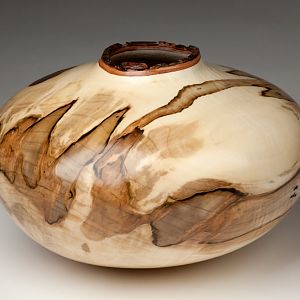These little vases are the first turnings using my Visual Calipers. They're replicas of small brass urns turned freehand by my uncle, Sgt. Richard Wylie, in the late 1940s. He died in 1950, and I've had to guess at a few historical details.
Sgt. Wylie worked in the office of Graves Registration after WW2. Thanks to his (and others') efforts, relatives of fallen servicemen and women can identify the locations of their graves in Europe. I suppose he dealt with the undertaking industry, and derived inspiration from crematory urns. Remarkably, the small urns measure 1" diameter x 1.6" high - very close to the "golden ratio" of 1.618. I don't know if Uncle Dick had any art training; I thought his profession was accounting. And he probably made them at an Army craft shop, or perhaps in the Pentagon's machine shop. I don't know if the Pentagon actually has a machine shop, but I'd be surprised if it doesn't.
At any rate, I measured the small urns carefully, and made a drawing in AutoCAD. I refined some of the measurements, and enlarged to a workable size. My first target prototype size needed Pine blanks that would have needed a lot of preliminary work. So I measured some smaller logs of Chinaberry, and reduced the scale of the drawing; printed two copies for the patterns, and proceeded to turn both copies over a period of about 8 hours maximum in two days. My reason for urgency was an impending meeting of our WT club at the shop of a retired Air Force General. The military connection was too good to resist.
Chinaberry, 2 5/8" x 4 1/2" (67mm x 115mm), EEE + paste wax, with paintball tubes for flowers.








